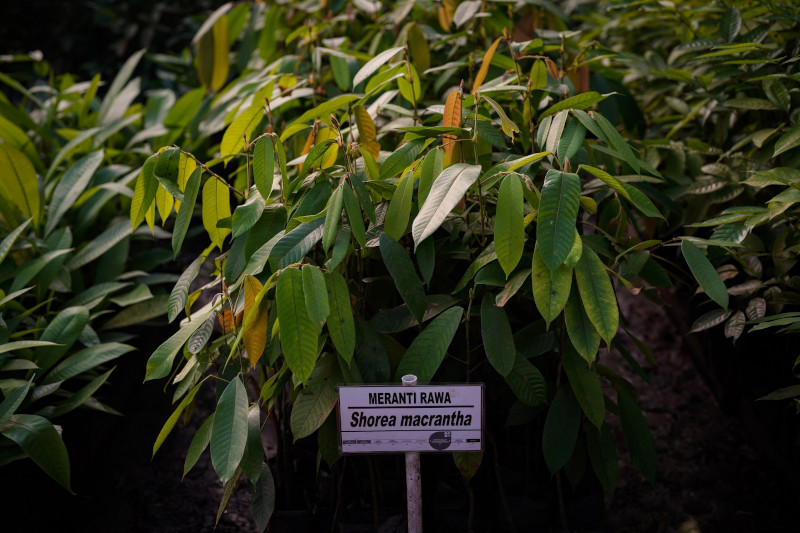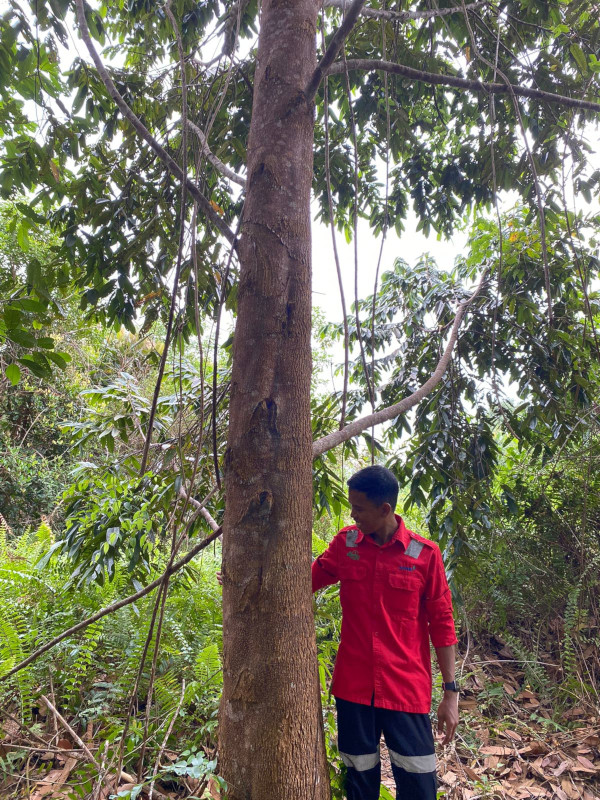January 03, 2024
Located right in the heart of Indonesia, Riau is home to some of the country’s richest and most diverse natural landscapes. For botanists, one of the brightest gems in this tropical treasure trove has to be Meranti rawa – a rare tree species that plays a vital role in its ecosystem. This jungle giant is also central to the ambitious conservation efforts currently underway at Restorasi Ekosistem Riau (RER).
Want to know more about this magnificent tree? In this article, we’ll explore the unique ecology of Meranti rawa, learn about its place in the natural world, and find out how RER replanting programs are helping protect this Critically Endangered species from extinction in the wild. From root to canopy, let’s take a closer look.
About Meranti Rawa
Meranti rawa (Shorea macrantha) is a towering hardwood tree that belongs to the Dipterocarpaceae family. It can be found in the lowland rainforests and swamps of Southeast Asia, in places like Sumatra, Peninsula Malaysia, and Borneo. In Indonesia, it’s known simply as pohon meranti. But in Malaysia it has another, spookier name – kepong hantu – which means ‘haunted place.’
You can recognize one of these forest giants by its impressive size. Fully-grown, Meranti rawa can stand up to 60 meters (200 feet) tall. Another distinguishing feature is their large, glossy leaves, which fan out in a broad canopy at the end of a long and rounded trunk.
Ecosystem Value
Meranti rawa is what’s known as a keystone species, meaning that lots of other organisms depend on them for survival; if trees like these disappear from their ecosystem, they take a lot of life with them.
As a dominant tree species in the lowland rainforests of Riau, Meranti rawa provides food and shelter for all kinds of animals. Its fruits and seeds are on the menu for lots of birds and mammals, which helps maintain biodiversity in the forest.

But the ecosystem benefits of Meranti rawa go much further than that. Their enormous, tangled root systems fan out underground in all directions, knitting the soil together and preventing erosion when it rains. Rooted in this solid foundation, the whole rainforest is able to grow and flourish.
Looking beyond the forest, species like Meranti rawa are vital to the health and continued productivity of our planet. With their ability to store carbon and pump oxygen into our atmosphere, they are an important ally in our fight against climate change.
Threats and conservation status
Unfortunately, when looking for value in the natural world, many people fail to see the wood for the trees. Remember that big, round trunk? Well, the precious hardwood inside is a highly prized material in furniture and construction. Combined with an eye-catching appearance, this makes Shorea macrantha an obvious target for loggers.
After many years of logging and habitat loss, Meranti rawa is now Critically Endangered on the International Union for Conservation of Nature (IUCN) Red List. Without urgent action, there is an ‘extremely high’ risk it will become extinct in the wild.
RER Conservation Efforts
But help is on the way. Because Meranti rawa grows in the peatland and lowland forests of Riau, it is one of the many plant species protected and nurtured by RER.
With the help of our nursery, we’re working round the clock to safeguard this species. The nursery has room for up to 25,000 seedlings, making it the engine room of our conservation efforts.
By growing seedlings in these sheltered and controlled conditions, we can ensure the next generation of Meranti rawa gets the helping hand they need to grow big and strong. When ready, these seedlings can be replanted in the forest, adding to the wild population.
Working Alongside Local Communities
We’re also working to protect the adult trees that remain. As part of our regular patrols, we look for signs of disturbance to make sure each individual tree is safe. Our patrols are complemented by education and outreach into nearby communities, so that people learn to appreciate the true value of these trees.
To make sure our restoration efforts are aligned with the needs of the people living and working in the region, RER implements a range of community initiatives that focus on sustainable land management practices. Over time, this type of engagement has helped recruit local people to the cause of reforestation, and ultimately contributed to the long-term success of the RER project.
A Major Success Story in the RER Replanting Program
Back in 2014, the RER team planted the first generation of homegrown Meranti rawa seedlings in the forest. Now, as we starting the year of 2024, one of those trees has grown to a height of over 6 meters (almost 20 feet) tall. Although that’s only a tenth of its adult size, it represents a massive achievement.

As RER continues on its mission towards ecological restoration, Meranti rawa offers a symbol of resilience and hope. Its success – and its contribution to the wider survival of the species – represents a major victory for the RER team, who are working tirelessly to safeguard natural, ecological balance in Riau.
By planting and nurturing Shorea macrantha and other indigenous species, RER intends to restore the natural balance of the landscape, providing a sustainable future for both the natural environment and the communities who depend on it.
Like that first seedling we planted in 2014, we will keep on growing onwards and upwards until we reach our goal. Following these collective efforts, we hope Meranti rawa will continue to stand tall in Sumatra for generations to come.